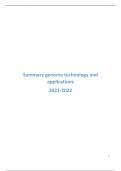Summary
Summary of the course: Genome Technology and Applications (19/20)
- Course
- Institution
Summary of the course: Genome Technology and Applications (19/20): This summary contains notes taken during the lectures/seminares and all information needed to pass the exam of 'Genome Technology and Applications' given in the first Master year of Biomedical Sciences. This includes all information...
[Show more]



